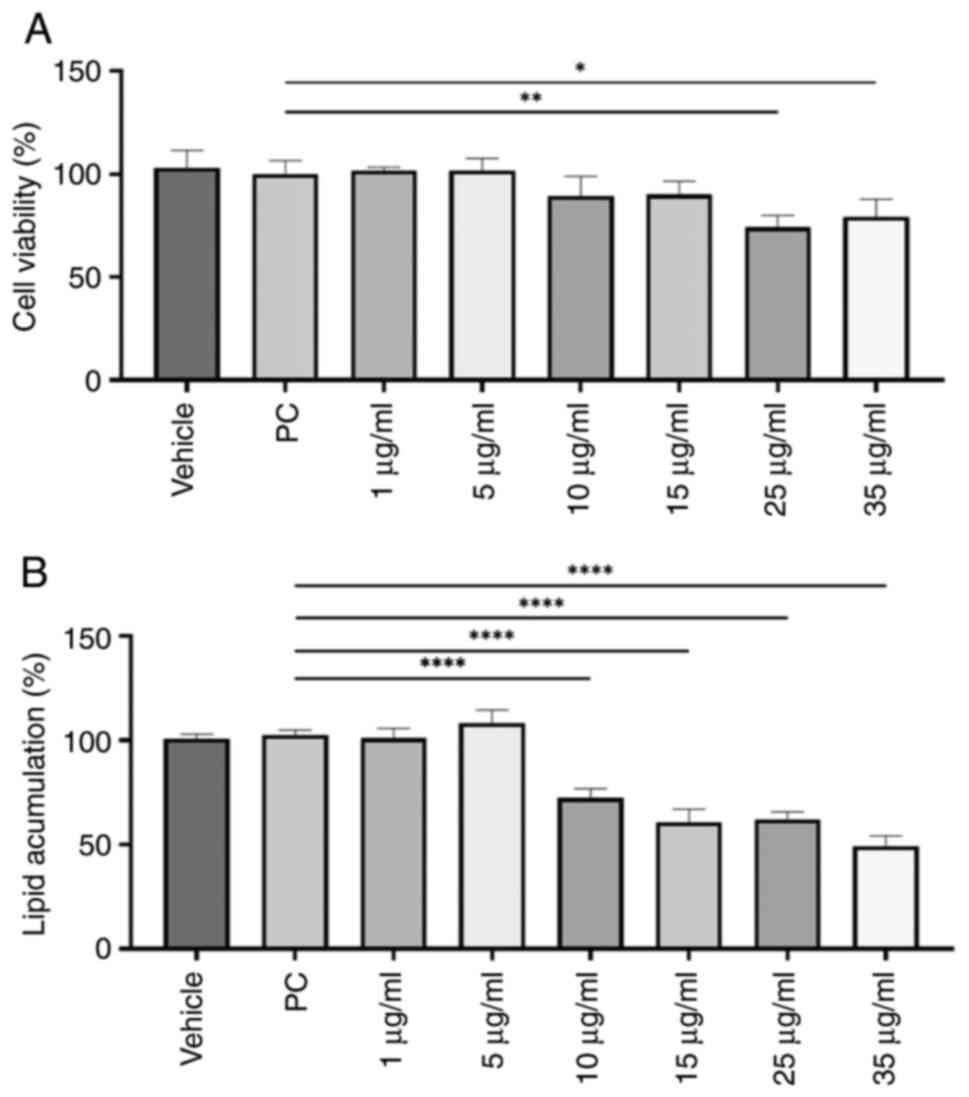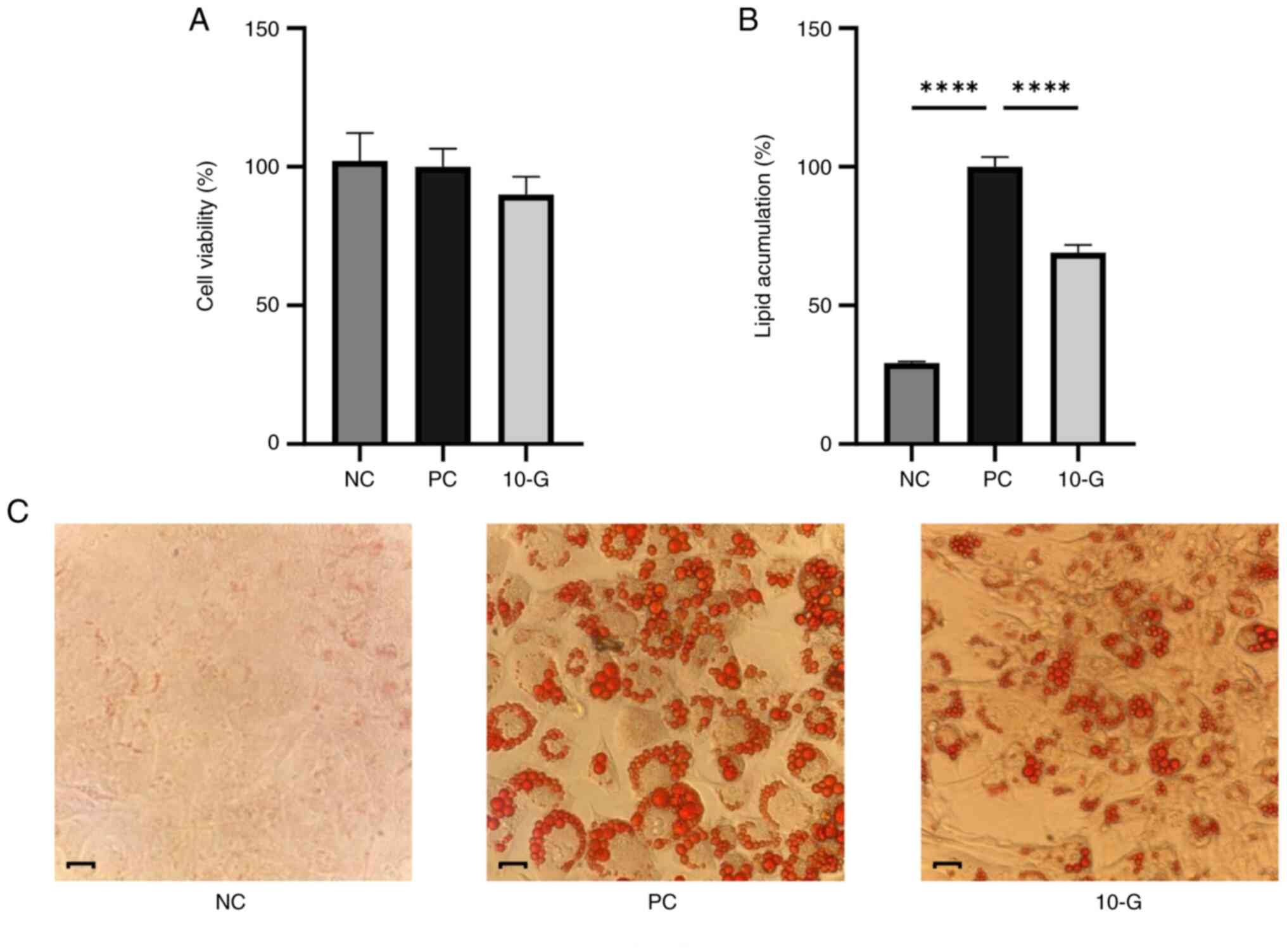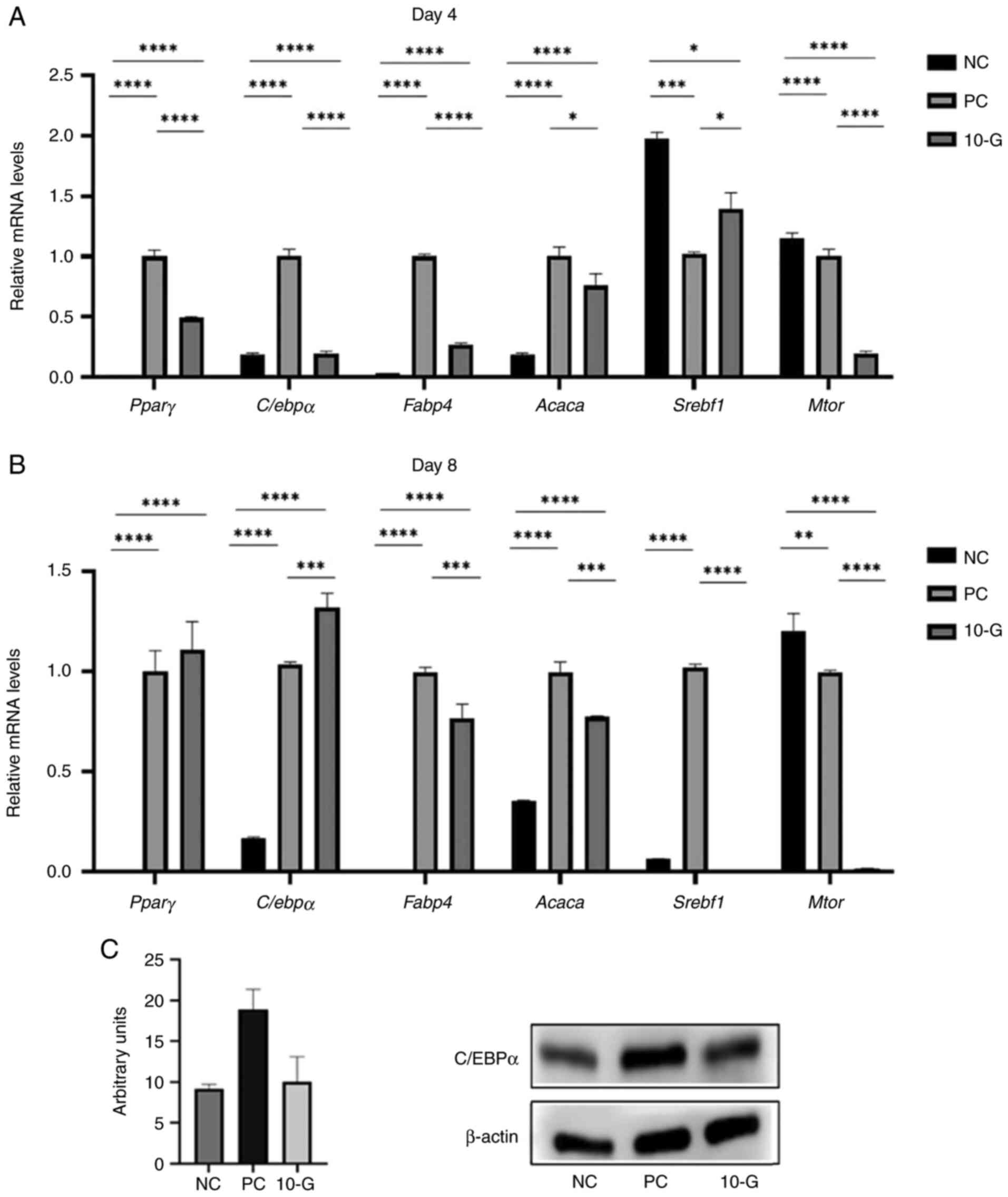|
1
|
González-Muniesa P, Mártinez-González MA,
Hu FB, Després JP, Matsuzawa Y, Loos RJF, Moreno LA, Bray GA and
Martinez JA: Obesity. Nat Rev Dis Prim. 3(17034)2017.PubMed/NCBI View Article : Google Scholar
|
|
2
|
Blüher M: Obesity: Global epidemiology and
pathogenesis. Nat Rev Endocrinol. 15:288–298. 2019.PubMed/NCBI View Article : Google Scholar
|
|
3
|
World Health Organization (WHO): Obesity
and overweight. WHO, Geneva, 2021.
|
|
4
|
Heymsfield SB and Wadden TA: Mechanisms,
pathophysiology, and management of obesity. N Engl J Med.
376:254–266. 2017.PubMed/NCBI View Article : Google Scholar
|
|
5
|
Doo M and Kim Y: . Obesity: Interactions
of genome and nutrients intake. Prev Nutr Food Sci. 20:1–7.
2015.PubMed/NCBI View Article : Google Scholar
|
|
6
|
Mao QQ, Xu XY, Cao SY, Gan RY, Corke H,
Beta T and Li HB: Bioactive compounds and bioactivities of ginger
(zingiber officinale roscoe). Foods. 8(185)2019.PubMed/NCBI View Article : Google Scholar
|
|
7
|
Wang J, Ke W, Bao R, Hu X and Chen F:
Beneficial effects of ginger Zingiber officinale Roscoe on obesity
and metabolic syndrome: A review. Ann N Y Acad Sci. 1398:83–98.
2017.PubMed/NCBI View Article : Google Scholar
|
|
8
|
Saravanan G, Ponmurugan P, Deepa MA and
Senthilkumar B: Anti-obesity action of gingerol: Effect on lipid
profile, insulin, leptin, amylase and lipase in male obese rats
induced by a high-fat diet. J Sci Food Agric. 94:2972–2977.
2014.PubMed/NCBI View Article : Google Scholar
|
|
9
|
Semwal RB, Semwal DK, Combrinck S and
Viljoen AM: Gingerols and shogaols: Important nutraceutical
principles from ginger. Phytochemistry. 117:554–568.
2015.PubMed/NCBI View Article : Google Scholar
|
|
10
|
Tzeng TF and Liu IM: 6-Gingerol prevents
adipogenesis and the accumulation of cytoplasmic lipid droplets in
3T3-L1 cells. Phytomedicine. 20:481–487. 2013.PubMed/NCBI View Article : Google Scholar
|
|
11
|
Li C and Zhou L: Inhibitory effect
6-gingerol on adipogenesis through activation of the Wnt/β-catenin
signaling pathway in 3T3-L1 adipocytes. Toxicol In Vitro. 30 (1 Pt
B):394–401. 2015.PubMed/NCBI View Article : Google Scholar
|
|
12
|
Rani MP, Krishna MS, Padmakumari KP, Raghu
KG and Sundaresan A: Zingiber officinale extract exhibits
antidiabetic potential via modulating glucose uptake, protein
glycation and inhibiting adipocyte differentiation: An in vitro
study. J Sci Food Agric. 92:1948–1955. 2012.PubMed/NCBI View Article : Google Scholar
|
|
13
|
Suk S, Seo SG, Yu JG, Yang H, Jeong E,
Jang YJ, Yaghmoor SS, Ahmed Y, Yousef JM, Abualnaja KO, et al: A
bioactive constituent of ginger, 6-shogaol, prevents adipogenesis
and stimulates lipolysis in 3T3-L1 Adipocytes. J Food Biochem.
40:84–90. 2016.
|
|
14
|
Wang J, Zhang L, Dong L, Hu X, Feng F and
Chen F: 6-Gingerol, a functional polyphenol of ginger, promotes
browning through an AMPK-Dependent Pathway in 3T3-L1 Adipocytes. J
Agric Food Chem. 67:14056–14065. 2019.PubMed/NCBI View Article : Google Scholar
|
|
15
|
Cheng Z, Xiong X, Zhou Y, Wu F, Shao Q,
Dong R, Liu Q, Li L and Chen G: 6-gingerol ameliorates metabolic
disorders by inhibiting hypertrophy and hyperplasia of adipocytes
in high-fat-diet induced obese mice. Biomed Pharmacother.
146(112491)2022.PubMed/NCBI View Article : Google Scholar
|
|
16
|
Hong KH, Um MY, Ahn J and Ha TY:
6-Gingerol ameliorates adiposity and inflammation in adipose tissue
in high fat diet-induced obese mice: Association with regulating of
adipokines. Nutrients. 15(3457)2023.PubMed/NCBI View Article : Google Scholar
|
|
17
|
Jiao W, Mi S, Sang Y, Jin Q, Chitrakar B,
Wang X and Wang S: Integrated network pharmacology and cellular
assay for the investigation of an anti-obesity effect of 6-shogaol.
Food Chem. 374(131755)2022.PubMed/NCBI View Article : Google Scholar
|
|
18
|
Park SH, Jung SJ, Choi EK, Ha KC, Baek HI,
Park YK, Han KH, Jeong SY, Oh JH, Cha YS, et al: The effects of
steamed ginger ethanolic extract on weight and body fat loss: A
randomized, double-blind, placebo-controlled clinical trial. Food
Sci Biotechnol. 29:265–273. 2020.PubMed/NCBI View Article : Google Scholar
|
|
19
|
Zick SM, Djuric Z, Ruffin MT, Litzinger
AJ, Normolle DP, Alrawi S, Feng MR and Brenner DE: Pharmacokinetics
of 6-Gingerol, 8-Gingerol, 10-Gingerol, and 6-Shogaol and conjugate
metabolites in healthy human subjects. Cancer Epidemiol Biomarkers
Prev. 17:1930–1936. 2008.PubMed/NCBI View Article : Google Scholar
|
|
20
|
Suk S, Kwon GT, Lee E, Jang WJ, Yang H,
Kim JH, Thimmegowda NR, Chung MY, Kwon JY, Yang S, et al:
Gingerenone A, a polyphenol present in ginger, suppresses obesity
and adipose tissue inflammation in high-fat diet-fed mice. Mol Nutr
Food Res. 61(10.1002/mnfr.201700139)2017.PubMed/NCBI View Article : Google Scholar
|
|
21
|
Livak KJ and Schmittgen TD: Analysis of
relative gene expression data using real-time quantitative PCR and
the 2(-Delta Delta C(T)) Method. Methods. 25:402–408.
2001.PubMed/NCBI View Article : Google Scholar
|
|
22
|
Kraus NA, Ehebauer F, Zapp B, Rudolphi B,
Kraus BJ and Kraus D: Quantitative assessment of adipocyte
differentiation in cell culture. Adipocyte. 5:351–358.
2016.PubMed/NCBI View Article : Google Scholar
|
|
23
|
Quintero-Fabián S, Ortuño-Sahagún D,
Vázquez-Carrera M and López-Roa RI: Alliin, a garlic (Allium
sativum) compound, prevents LPS-induced inflammation in 3T3-L1
adipocytes. Mediators Inflamm. 2013(381815)2013.PubMed/NCBI View Article : Google Scholar
|
|
24
|
Lee GH, Peng C, Jeong SY, Park SA, Lee HY,
Hoang TH, Kim J and Chae HJ: Ginger extract controls mTOR-SREBP1-ER
stress-mitochondria dysfunction through AMPK activation in obesity
model. J Funct Foods. 87(104628)2021.
|
|
25
|
Ahn EK and Oh JS: Inhibitory effect of
galanolactone isolated from Zingiber officinale Roscoe
extract on adipogenesis in 3T3-L1 cells. J Korean Soc Appl Biol
Chem. 55:63–68. 2012.
|
|
26
|
Madsen MS, Siersbæk R, Boergesen M,
Nielsen R and Mandrup S: Peroxisome proliferator-activated receptor
γ and C/EBPα synergistically activate key metabolic adipocyte genes
by assisted loading. Mol Cell Biol. 34:939–954. 2014.PubMed/NCBI View Article : Google Scholar
|
|
27
|
Liu GY and Sabatini DM: mTOR at the nexus
of nutrition, growth, ageing and disease. Nat Rev Mol Cell Biol.
21:183–203. 2020.PubMed/NCBI View Article : Google Scholar
|
|
28
|
Lee PL, Jung SM and Guertin DA: . The
complex roles of mechanistic target of rapamycin in adipocytes and
beyond. Trends Endocrinol Metab. 28:319–339. 2017.PubMed/NCBI View Article : Google Scholar
|
|
29
|
Ricoult SJ and Manning BD: The
multifaceted role of mTORC1 in the control of lipid metabolism.
EMBO Rep. 14:242–251. 2013.PubMed/NCBI View Article : Google Scholar
|
|
30
|
Lee PL, Jung SM and Guertin DA: The
complex roles of mechanistic target of rapamycin in adipocytes and
beyond. Trends Endocrinol Metab. 28:319–339. 2017.PubMed/NCBI View Article : Google Scholar
|
|
31
|
Cave E and Crowther NJ: The Use of 3T3-L1
murine preadipocytes as a model of adipogenesis. Methods Mol Biol.
1916:263–272. 2019.PubMed/NCBI View Article : Google Scholar
|
|
32
|
Okamoto M, Irii H, Tahara Y, Ishii H,
Hirao A, Udagawa H, Hiramoto M, Yasuda K, Takanishi A, Shibata S
and Shimizu I: Synthesis of a new [6]-gingerol analogue and its
protective effect with respect to the development of metabolic
syndrome in mice fed a high-fat diet. J Med Chem. 54:6295–6304.
2011.PubMed/NCBI View Article : Google Scholar
|
|
33
|
Liang T, Xing Z, Jiang L and Zhu JJ:
Tailoring nanoparticles for targeted drug delivery: From organ to
subcellular level. VIEW. 2(20200131)2021.
|
|
34
|
Geraili A, Xing M and Mequanint K: Design
and fabrication of drug-delivery systems toward adjustable release
profiles for personalized treatment. VIEW. 2(20200126)2021.
|


















